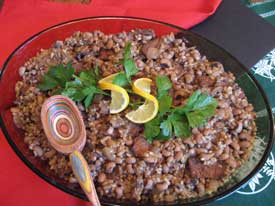Good Bite and Good Luck
By Chuck Sudo in Food on Dec 31, 2008 3:40PM
 One of the fascinating aspects of writing about food is the common ground we often discover between seemingly disparate cultures. It can sometimes be the use of an ingredient, similar table settings, or preparations of dishes that triggers a sense of familiarity that we aren't as different as we appear. Long before technology closed the distance between nations and made communication almost immediate, we became a global village by breaking bread.
One of the fascinating aspects of writing about food is the common ground we often discover between seemingly disparate cultures. It can sometimes be the use of an ingredient, similar table settings, or preparations of dishes that triggers a sense of familiarity that we aren't as different as we appear. Long before technology closed the distance between nations and made communication almost immediate, we became a global village by breaking bread.
Take New Year's, for example. This time of year is often regarded as a time for renewal, for new beginnings, for hope. In the resolutions we make and the hopes we harbor for the new year, we often wish for a little bit of luck in addition to the application of effort. Again: different cultures, common themes.
Often, certain foods are prepared this time of year in the hopes of facilitating luck or prosperity. My family has Southern roots on my mother's and stepfather's side, and Greek on my father's. From my mother and stepdad I became intimately familiar with being served black-eyed peas and ham hocks, sometimes hoppin' john, and fish on New Year's Day. Black-eyed peas have long been eaten in the South to bring good luck and wealth.
When the Great Migration brought waves of blacks to Chicago and other industrial centers of the north and midwest, they brought those traditions with them. Any soul food joint worth its license has Black-eyed peas on the menu. Black-eyed peas share a similarity with lentils, peas, beans and legumes eaten in other cultures as a symbol of prosperity and luck. It isn't uncommon in Italian families to be served lentil soup on New Year's Day. Lentils represent coins, which translate into prosperity.
Fish is another common food eaten by different cultures on New Year's Day. Fish represents the integrity of the family. Italians and other Mediterranean countries serve baccala, or dried and salted cod. Chinese often serve a whole fish, head to toe. Most often, whitefish is the preferred catch, although blackfish can sometimes be found in Cantonese cuisine. Additionally, many Chinese tables are laid out with four fresh and four dried fruits. China means "Little Kingdom;" the four fruits represent the four corners of the earth. Larger gatherings in China may also place four large courses on the table, representative of imperial ideologies.
From my father's side comes the Greek tradition of vasilopita, which is a cake baked with a coin inside. That tradition comes from Ottoman times. Greeks during the reign of the Turks were heavily taxed, and it is believed that a Greek bishop recovered a large portion of the country's riches from the Ottomans. When the Greeks couldn't agree as to who was owed what, legend has it that St. Basil asked women to bake a large cake containing the valuables. When Basil sliced the cake, the riches miraculously returned to their rightful owners. Today, the person who bites into the coin of a vasilopita is supposedly blessed with good luck.
The Turks themselves are no strangers to culinary superstition. Turkish families break open a pomegranate to symbolize family unity and sustenance, a tradition pre-dating Ottoman times. In Jewish homes apples and honey cake are often served, representing sustenance after periods of hunger and deprivation. Poppy seeds are often used in Central European cuisines for its purported ability to bring prosperity. Hebrews adapted the poppy seed into their own cooking and traditions, especially after immigrating to the New World.
These days, I've co-opted my mother's black-eyed peas and ham hocks recipe and added a personal twist. I eat a small bowl of it paired with a glass of Mumm Extra Dry champagne, another common New Year's tradition. That specific bubbly was the first one I remember actually taking a liking to, and I pour it only on New Year's Day to honor the blessings of the previous twelve months.